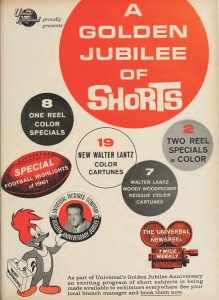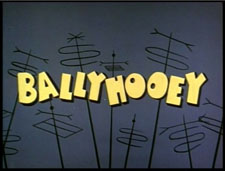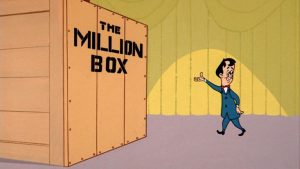By the early 1960’s, theatrical short subjects – and in particular, the Hollywood cartoon – seemed to be on its ante-penultimate legs.
M-G-M was getting by on reissues, having closed their studio down in 1957. And Columbia was getting ready to release shorts that looked like television cartoons–because, for all practical intents and purposes, the “Loopy de Loop” shorts were no better than the product seen on Hanna-Barbera television shows of the period.
 Other studios–Warners, Paramount, Walter Lantz and Terrytoons–were still hard at it. But budgets were lower, as were profit expectations. At times, the producers, directors, animators and writers seemed to be going through the motions.
Other studios–Warners, Paramount, Walter Lantz and Terrytoons–were still hard at it. But budgets were lower, as were profit expectations. At times, the producers, directors, animators and writers seemed to be going through the motions.
And there was the competition from the new kid on the block–television.
Production of cartoons for television had increased tremendously. And while there were many veterans of theatrical animation working the new cartoon studios, they weren’t able to feature all of their well-established talents, due to the budgets for TV cartoons–which were even tighter than those on theatrical releases.
Yet, the writers still found occasional inspiration in the idea of the game show–which was gong through its own crisis at the time.
The revelations that many of the prime-time, big-money quizzes were, in fact, rigged, shook the industry up to a considerable degree–as did the revelations that came out later about sponsorial interference in programming, scripts, and suchike–even in dramatic presentations.
Most of the big-money shows had disappeared by the New Year of 1959–by the New Year of 1960, they were but a distant memory.
This makes Ballyhooey (copyrighted and released in 1960) rather an anomaly.

As the big-money quizzes were gone, and efforts were being made to forget them, it is curious that Walter Lantz should use such a device as the plot hook for a “Woody Woodpecker” cartoon.
Although the fictitious “Win The Whole Wide World'” game show is the plot hook, the real intent of this cartoon is not to skewer any particular game show–it’s to skewer television commercials–which, even then, were perceived as being too frequent in number, too loud, and far too annoying.
 In fact, out of this cartoon’s six minutes and nineteen seconds (more or less) running time, a good three minutes are devoted to takeoffs on advertisements for various products.
In fact, out of this cartoon’s six minutes and nineteen seconds (more or less) running time, a good three minutes are devoted to takeoffs on advertisements for various products.
We may ever know how long the gestation period for a Walter Lantz short of that time was. One suspects that it was a good deal shorter than that of many Warner Brothers cartoons of a decade earlier–some of whom had gestation periods of two years from recording of some tracks to the finished product; from copyright to release.
If the cartoon was a glimmer in some animator’s eye when the big money quizzes were still on–say in the summer or fall of 1958–one could understand the inspiration. On the other hand, one of the “commercials” seen in this short is for “Polka-Dot Toothpaste”–which was a reaction to “Stripe”-a toothpaste introduced by Lever Brothers around 1959. (That’s when I first heard of it, anyway.)
 Voice artists Dal McKennon and Paul Frees (who joined Grace Stafford Lantz on this one, and get name-credited), should have been used to this kind of humor.
Voice artists Dal McKennon and Paul Frees (who joined Grace Stafford Lantz on this one, and get name-credited), should have been used to this kind of humor.
In fact, Frees had been involved in a long sketch, “The Late Late Late Late Movies”, which Spike Jones had recorded first as a two-sided, two-part single for Liberty.
The cut was used again–with a different “bed” under the various spoofs of contemporary advertisements-on the Jones LP “Omnibust”. Most of the vocal work on that cut is by Frees, using various of his stock voices.
And yes–in some markets, it was common to have movies–and even reruns of television shows–hosted by an on-air personality who would also be bidden to read some of the commercials live. And this wasn’t restricted to the horror-show hosts on Saturday nights.
It’s no wonder that Gracie Stafford Lantz seems to have the smallest amount of dialogue among the three of them in this cartoon–and the least action and the most reaction!

Except for the cameo appearance of Bugs Bunny at the end of Frank Tashlin’s Porky Pig’s Feat (1943), Bugs ad Daffy had not met–neither as friends nor as adversaries. But after the trio of cartoons in which both of them ran athwart clueless hunter Elmer Fudd–Rabbit Fire, Rabbit Seasoning and Duck! Rabbit! Duck!–Bugs and Daffy were pretty much in a state of rivalry.
 When they would meet–as in Show Biz Bugs or People Are Bunny or The Abominable Snow Rabbit–it would be the sang-froid of Bugs Bunny versus the hyperactivity of Daffy Duck–with the little black duck getting the worst of it.
When they would meet–as in Show Biz Bugs or People Are Bunny or The Abominable Snow Rabbit–it would be the sang-froid of Bugs Bunny versus the hyperactivity of Daffy Duck–with the little black duck getting the worst of it.
Such is the case with The Million-Hare, copyrighted in 1962 and released in 1963.
This cartoon shows traits it shares with other Bugs Bunny shorts of the time. There’s a certain talky quality that runs through these autumnal ‘toons–and, in all that palaver, a certain similarity to the typical Hanna-Barbera product that was all over television at the time.
 To encapsulate: Bugs is having Daffy as a house guest–but all the Duck wants to do is to sit and watch television. His favorite show is “Beat Your Buddy”, a game show. for friends. When Bugs’ and Daffy’s names are drawn from the “buddy barrel”, they have to race each other to the studio to claim “the million box.” I don’t need to go through all the machinations here. The cartoon is visible on the Web, (and copyright be damned!)
To encapsulate: Bugs is having Daffy as a house guest–but all the Duck wants to do is to sit and watch television. His favorite show is “Beat Your Buddy”, a game show. for friends. When Bugs’ and Daffy’s names are drawn from the “buddy barrel”, they have to race each other to the studio to claim “the million box.” I don’t need to go through all the machinations here. The cartoon is visible on the Web, (and copyright be damned!)
Although Bob McKimson directed this one, as he had done several television satires in the 1950’s, he no longer had Tedd Pierce writing for him. Instead, story credit here goes to Dave Detiege.
And one might wonder where–or how–Dave Detiege got the idea for “Beat Your Buddy”. I have never head of a television game show–before this cartoon, or since–that sounds like it could be the inspiration for “Beat Your Buddy”.
In fact, some folks might wonder if Detiege was predicting trends in entertainment of some forty years later. For “Beat Your Buddy” sounds like one of the “reality” shows that have clogged television schedules for the past twenty years or so. On the surface, it might be compared to “The Amazing Race”–although that show is actually more like a road-rally on steroids than anything else.
That’s a lot of supposition for an autumnal Bugs Bunny cartoon!
Meanwhile, back East. . .
Paramount was producing six-minute time fillers that filled a space in the programs they offered to theaters.
But, having sold off their best characters to a comic-book publisher, they foud that they didn’t have anybody left. On top of that, most of the staff was getting on in years. Some would wind up not being much longer for this world.
 And that’s where Whiz Quiz Kid (1963) comes in.
And that’s where Whiz Quiz Kid (1963) comes in.
The big-money quizzes had become an increasingly-distant memory by the time this cartoon was written. But there were–and would be–small-money quizzes for subteen and teenage contestants.
In most cases, they were locally produced knockoffs of “General Electric College Bowl”, with contestants from local high schools. Maybe if they were lucky, the winners would get a small scholarship.
In this cartoon, a failing TV network tries to put on a “Kiddie Quiz Show’–then make the questions so hard that the any kiddie contestant cannot answer them. Thus,, they don’t have to give out any prizes.
They fail to account for Oliver Owl, who is as brainy as any animated owl you ever saw. The television people are stereotypes of business/advertising people. The images presented here would be familiar to anyone who had ever heard Stan Frebeg’s “Green Chri$tma$”, or had gone to see the Broadway success “How To Succeed In Business Without Really Trying”.
The cartoon does show the “New York’ attitude that was quite evident in Paramount cartoons of the time–especially in the “Swiifty and Shorty” cartoons of the day, which served as vehicles for the humor and talent of Eddie Lawrence.
By this time, the theatrical cartoon was wheezing towards its ultimate finish.


 James Parten has overcome a congenital visual disability to be acknowledged as an expert on the early history of recorded sound. He has a Broadcasting Certificate (Radio Option) from Los Angeles Valley College, class of 1999. He has also been a fan of animated cartoons since childhood.
James Parten has overcome a congenital visual disability to be acknowledged as an expert on the early history of recorded sound. He has a Broadcasting Certificate (Radio Option) from Los Angeles Valley College, class of 1999. He has also been a fan of animated cartoons since childhood.












































What I remember about The Million Hare was two comedic scenes where Daffy falls off a cliff and later tries to cross a bridge that was under construction and screaming “AAAAAAAAAAAAAAAAAAIIIIIIIIIIIIIIIIIIEEEEEEEEEEEEEEEEEEEEEEEEE!!!!!!!!!!” as he fell and Bugs was saying that he’d remember to fly as Daffy fell off the cliff and if he’d remembered to swim when Daffy and his motor scooter fell into the river.
Besides “People are Funny” there was another stunt show titled “Truth or Consequences” and a giant board game show called “Video Village”; there were probably others (“Supermarket Sweep” and “Let’s Make a Deal” came a bit later). So “Beat Your Buddy” wouldn’t have seemed that outlandish a notion. It could also be a spin on local radio / TV games where a listener / viewer was named on the air and had to call in.
The title references “The Millionaire”, a successful dramatic show that was running in syndication by then. Maybe it started as a parody of that.
In my late-boomer youth there were still live hosts on local daytime movies; most notably “Dialing for Dollars” on KTVU. The host would spin a wheel and then call a randomly selected name. The person called would have to give the count (the wheel) and the amount of the prize. Johnny Carson’s “Tea Time Movie” sketches parodied the local hosts / pitchmen; I suspect the local hosts were long gone before Carson retired the sketch for good.
Paul Frees was the voice of the Millionaire and there was a parody of The Millionaire that was on a KFS Popeye cartoons in the 1960’s.
The opening gag of “Ballyhooey” – the “wide variety” of programming is all the same western – seems recycled from Tex Avery’s “TV of Tomorrow”. Seeing as Avery had been at Lantz’s just before this cartoon was made, one wonders if the initial script was developed for him. At the very least it’s clear that Alex Lovy is imitating Tex here.
The “animation” in Whiz Quiz Kid is painfully limited. It lacks even when compared to Hanna-Barbera’s TV work.
I still get a big kick out of it and that’s a lot for a 1960s cartoon on big screen..
This is a great post, but I couldn’t get the “BALLYHOOEY” link to work. All I got was a warning that NBC/Universal was blocking this content for copyright infringement, but the other two cartoons worked. If I’m not mistaken, “MILLION HARE” is available in really good quality, if anybody cares, on the single disk of BUGS BUNNY cartoons under the LOONEY TUNES SUPERSTARS banner…and without the intrusive laugh track that someone dragged onto the audio track on Daily Motion. These were terrific comic exaggerations of the game show as any generation knew it.
Universal must really care about this cartoon to take it down on a Sunday morning. Too bad they don’t care enough about it to release it on DVD.
Ye Editor is working on an alternative way to embed this cartoon into this post. Check in again later tonight.
Chuck, “Ballyhooey” IS on DVD. It’s part of the “Woody Woodpecker Show” special feature on volume 2 of the Woody Woodpecker and Friends Classic Cartoon Collection.
Thanks, Top Cat James! I was not thinking about the extras. But, I do wish they would have continued the series at least through the mid-sixties (to complete at least the Woody Woodpecker cartoons from my childhood.) I would have liked them to complete the Andy Panda’s and Chilly Willy’s as well!
I M Flabbergasted that there was a WB film i had not seen. I concur, there is NOTHING more “embarraskin’ ” than a laff track…espesh …to an animated (theatrical) film. The Paramount films, i find, are 1100 times more appealing than ANY other studio (at this stage).
It originally didn’t have a laugh track. I have no idea why this uploader put one on there. It’s a pretty stupid idea in my opinion.
As I said, I believe the BUGS BUNNY cartoon appears (without laugh track of course) on the BUGS BUNNY disk from the short-lived LOONEY TUNES SUPERSTARS series; and, yes, the WOODY WOODPECKER cartoon does appear on disk 3 of volume 2 of the incredible WOODY WOODPECKER AND FRIENDS collection. If you dont’ already have it, I hope you can find it. It is well worth owning.
Just be thankful ABC didn’t ask WB to sick one one their cartoons for “The Bugs Bunny Show”.
What I’m curious about on Whiz Quiz Kid is the character Oliver Owl and if he’s (even though this was a Paramount/Famous Studios Noveltoon) was similar to Warner Brothers’ Oliver Owl who appeared in the Beans the Cat cartoons in the 1930’s and was in I Haven’t Got a Hat? (1935) .
I’m sure it was a coincidence that the name Oliver was used for Paramount’s cartoon. They simply needed a smart character (owls were often put into this category then) and giving him a name that starts with an “O” was all there is to it.
I believed this “Oliver Owl” (who was in another 1960’s Paramount cartoon that I can’t remember the title of) might be a rework of “Junior” who appeared in the earlier Noveltoon, “Teacher’s Pest” (1950).
I wouldn’t doubt you Nic.
William Lava is not noted for his song interpolation, but in “The Million-Hare” he treats us to Harry Warren’s “With Plenty of Money and You.”